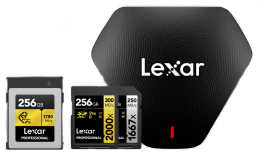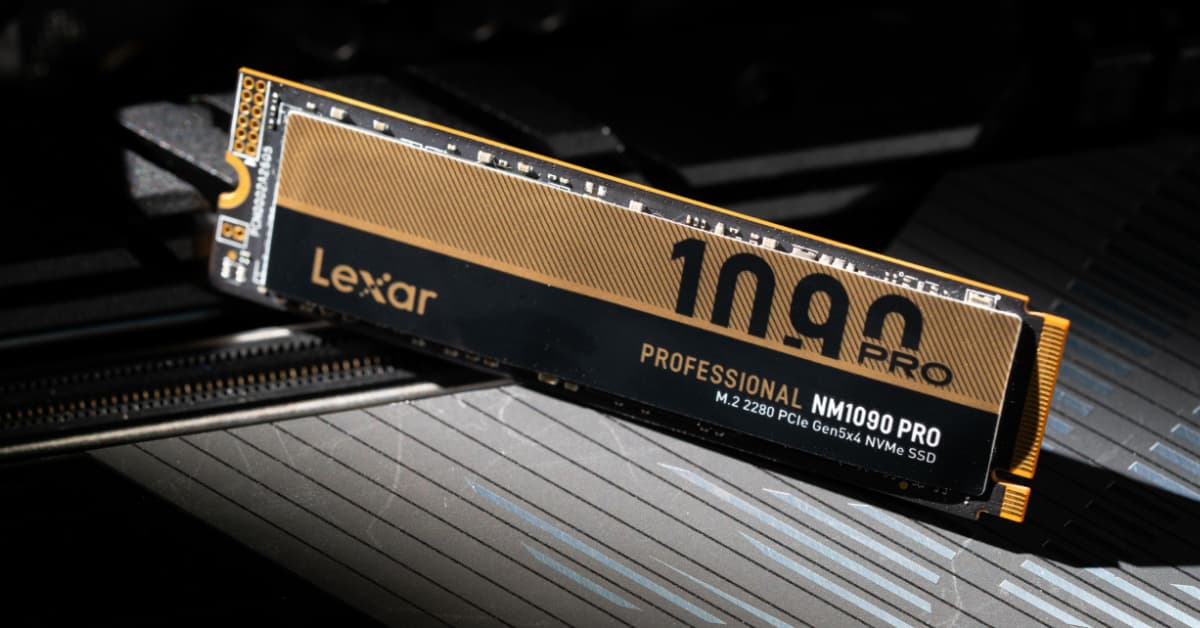
NAND flash memory is the technology that forms the foundation upon which all NVMe performance and capabilities are built. NAND flash memory is the same technology Lexar has perfected across our entire SSD lineup, from the entry-level Lexar® NQ780 M.2 2280 PCIe 4.0 NVMe SSD to our top-tier Lexar® NQ780 M.2 2280 PCIe 4.0 NVMe SSD.
NAND flash memory stores data in memory cells that can be electrically programmed and erased. Unlike RAM, which loses data when power is removed, NAND flash retains information indefinitely without power — a property called non-volatility. This characteristic makes NAND flash ideal for long-term storage applications.
NVMe technology represents a complete paradigm shift from traditional storage approaches. Unlike mechanical hard drives that rely on physical components spinning at thousands of RPMs, or even earlier SATA SSDs that were constrained by legacy interfaces, NVMe was designed from the ground up to leverage the full potential of solid-state memory and modern computing architectures.
Memory Cell Architecture
At the microscopic level, NAND flash memory consists of floating-gate transistors arranged in a three-dimensional grid structure. Each cell stores data by trapping electrons in the floating gate, which changes the threshold voltage of the transistor. When the controller reads the cell, it measures this voltage to determine whether the cell represents a binary 1 or 0.
Modern NAND flash has evolved to store multiple bits per cell through careful voltage level management. Single-level cell (SLC) technology stores one bit per cell, offering the highest performance and endurance. Multi-level cell (MLC) technology stores two bits per cell, Triple-level cell (TLC) stores three bits, and Quad-level cell (QLC) stores four bits per cell.
Our Lexar® Professional NM1090 PRO PCIe 5.0 SSD leverages advanced 232-layer 3D TLC NAND technology, which allows us to pack incredible storage density while maintaining exceptional performance characteristics. The three-dimensional stacking approach enables higher capacities without sacrificing the speed that professionals and gamers demand.
As we increase the number of bits per cell, we achieve higher storage density and lower cost per gigabyte, but with trade-offs in performance and endurance. This is why different applications benefit from different NAND types — enterprise workloads often prefer SLC or MLC for reliability, while consumer applications typically use TLC or QLC for cost-effectiveness.
Program/Erase Cycles and Wear Leveling
NAND flash memory has a fundamental limitation: each memory cell can only withstand a finite number of program/erase cycles before wearing out. This wear mechanism occurs because the electrical processes used to program and erase cells gradually damage the oxide layer that isolates the floating gate.
Modern SSD controllers implement sophisticated wear leveling algorithms to distribute program/erase cycles evenly across all memory cells. This ensures that no single area of the drive wears out prematurely, maximizing the overall lifespan of the storage device.
Our engineering teams continuously work to optimize these algorithms, ensuring that all Lexar NVMe SSDs — from the Lexar® NM790 M.2 2280 PCIe Gen 4×4 NVMe SSD with its excellent endurance ratings to the high-performance Lexar® Professional NM800 PRO M.2 2280 NVMe SSD — deliver consistent performance throughout their operational lifetime while maximizing endurance ratings for different usage scenarios.
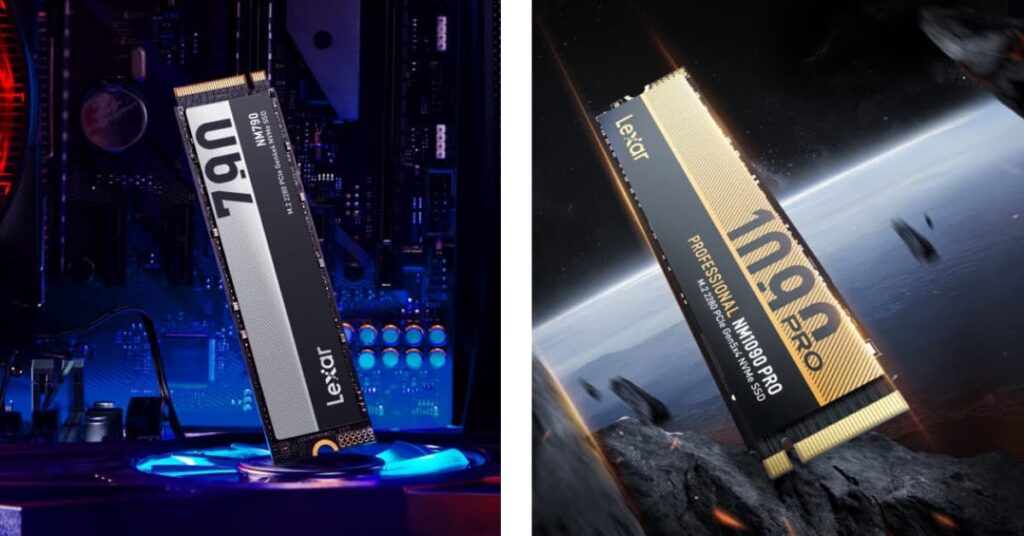
The NVMe Protocol: Revolutionizing Storage Communication
The Non-volatile memory express (NVMe) protocol represents a fundamental reimagining of how storage devices communicate with computer systems. Unlike older protocols designed for mechanical drives, NVMe was created specifically to leverage the capabilities of solid-state memory — capabilities that our entire NVMe SSD lineup is designed to maximize.
From AHCI to NVMe: A Paradigm Shift
Traditional storage interfaces like SATA were originally designed for hard disk drives, with protocols optimized for sequential access patterns and single command queues. The advanced host controller interface (AHCI) protocol, while functional, imposed significant bottlenecks when applied to solid-state storage.
AHCI supports a single command queue with up to 32 commands, which creates artificial limitations when dealing with SSDs capable of handling thousands of simultaneous operations. This architecture also introduces unnecessary software overhead and latency that makes sense for mechanical drives but becomes a liability with flash storage.
NVMe eliminates these limitations by implementing up to 65,535 command queues, with each queue supporting up to 65,536 commands. This massive parallelism allows the storage system to fully utilize the parallel nature of NAND flash memory and modern multi-core processors — a capability that drives our Lexar® Professional NM1090 PRO PCIe 5.0 SSD to achieve sequential read speeds up to 14,000MB/s and write speeds up to 13,000MB/s.
Direct PCIe Connection
One of NVMe’s most significant advantages is its direct connection to the PCIe bus, bypassing the storage controller hub that SATA devices must traverse. This direct connection reduces latency and increases bandwidth while providing dedicated communication channels between the storage device and the CPU.
PCIe lanes provide much higher bandwidth than SATA interfaces. While SATA III tops out at 600 MB/s, a single PCIe 3.0 lane provides nearly 1 GB/s of bandwidth, and NVMe SSDs typically use four lanes for approximately 4 GB/s of theoretical bandwidth. This is why our Lexar® NM790 M.2 2280 PCIe Gen 4×4 NVMe SSD can achieve up to 7,400MB/s read speeds — nearly 12 times faster than traditional SATA SSDs.
PCIe 4.0 and 5.0 implementations further double and quadruple these figures respectively. Our latest Lexar® Professional NM1090 PRO PCIe 5.0 SSD takes full advantage of PCIe 5.0’s massive bandwidth capabilities, delivering performance that would have been unimaginable just a few years ago.
This bandwidth advantage enables NVMe SSDs to deliver performance that would be impossible through traditional storage interfaces, supporting the high-speed data transfer requirements of modern applications like 4K video editing, large database operations, and real-time analytics.
Command Structure and Efficiency
NVMe commands are more efficient and streamlined compared to older protocols. The command structure eliminates unnecessary legacy compatibility layers and reduces the CPU overhead required for storage operations. This efficiency translates to lower system resource utilization and better overall performance.
The protocol also supports advanced features like namespace management, allowing a single NVMe drive to present multiple logical drives to the operating system, and power management capabilities that enable precise control over device power states for optimal energy efficiency. These features are implemented across our entire SSD lineup, including the Lexar® Professional NM800 PRO M.2 2280 NVMe SSD with its 12nm controller optimized for lower power consumption and longer battery life.

The SSD Controller: The Brain Behind the Performance
While NAND flash memory provides the storage medium and NVMe handles communication, the SSD controller serves as the intelligent intermediary that makes everything work seamlessly. This sophisticated piece of hardware and firmware performs countless operations per second to maintain data integrity, optimize performance, and extend drive lifespan.
Advanced Controller Technologies
Our Lexar® Professional NM1090 PRO PCIe 5.0 SSD features a cutting-edge 6nm controller that delivers exceptional thermal efficiency and performance optimization. At high performance loads, this advanced controller maintains peak temperatures that are 36% lower compared to competing drives using older 12nm controllers. This thermal advantage allows the drive to maintain consistent high performance even during sustained workloads.
Similarly, the Lexar® Professional NM800 PRO M.2 2280 NVMe SSD leverages its 12nm controller technology to produce lower power consumption and longer battery life for mobile computing scenarios, while still delivering blazing-fast performance with speeds up to 7,500MB/s read and 6,500MB/s write.
Garbage Collection and Write Amplification
One consequence of the FTL’s operation is that NAND flash blocks gradually fill up with invalid data – pages that are no longer referenced by the mapping table but still occupy physical space. Garbage collection is the process by which the controller reclaims this space.
During garbage collection, the controller identifies blocks containing invalid data, copies any remaining valid pages to new locations, and erases the entire block for future use. This process is essential for maintaining available write space but introduces write amplification — the phenomenon where the drive performs more physical writes than the host system requests.
Our engineering teams optimize garbage collection algorithms to minimize write amplification while maintaining consistent performance. Advanced techniques like background garbage collection, intelligent block selection, and over-provisioning all contribute to better overall drive behavior across our SSD lineup.
Error Correction and Data Integrity
NAND flash memory is inherently susceptible to various types of errors, from temporary read disturbances to permanent cell failures. The SSD controller implements multiple layers of error correction to ensure data integrity throughout the drive’s operational lifetime.
Low-level error correction codes (ECC) detect and correct bit errors within individual NAND pages. Our Lexar® Professional NM800 M.2 2280 NVMe SSD implements low-density parity check (LDPC) technology, which makes data transfers more reliable than ever by fixing data errors before they have a chance to slow you down.
More sophisticated techniques like LDPC codes can recover from more severe error conditions. The controller also implements bad block management, automatically remapping failed areas to spare memory cells. These error correction mechanisms operate transparently to the host system, maintaining data integrity even as the underlying NAND flash gradually wears over time.

Data Path: Following a File from Click to Storage
Understanding the complete data path from application to NAND flash memory illuminates how NVMe SSDs achieve their impressive performance characteristics. Let’s trace a file write operation through each stage of the storage stack, using examples from our current SSD lineup to illustrate real-world performance.
Application Layer to Operating System
When an application saves a file, it makes a system call to the operating system requesting a write operation. The OS file system (NTFS, ext4, APFS, etc.) translates this high-level request into block-level operations, determining which logical sectors need to be written and in what order.
Modern operating systems implement various optimizations at this stage, including write coalescing (combining multiple small writes into larger operations), write scheduling (reordering operations for better performance), and write caching (temporarily storing writes in system memory before committing to storage).
The file system also maintains metadata structures that track file locations, permissions, timestamps, and other attributes. These metadata updates often represent a significant portion of storage activity, especially for operations involving many small files – operations that benefit tremendously from the high random IOPS performance of drives like our Lexar® Professional NM800 PRO M.2 2280 NVMe SSD with its 4K random read/write performance up to 1,300K/1,200K IOPS.
NVMe Driver and Command Processing
The operating system’s NVMe driver translates file system requests into NVMe commands that the storage device can understand. This translation involves converting logical block addresses to the appropriate NVMe command format and managing the submission queues that communicate with the drive.
NVMe’s multiple queue architecture shines at this stage. The driver can distribute commands across multiple queues, potentially assigning different queues to different CPU cores or application threads. This parallelism reduces contention and improves overall system responsiveness – particularly beneficial for high-performance drives like our Lexar® Professional NM1090 PRO PCIe 5.0 SSD that can handle massive concurrent workloads.
The driver also handles features like command prioritization, allowing time-sensitive operations to take precedence over background tasks, and implements various power management policies that balance performance with energy efficiency.
Controller Processing and NAND Operations
When NVMe commands arrive at the SSD controller, they enter a sophisticated processing pipeline. The controller’s firmware first validates the commands, checks for any necessary security or encryption operations, and determines the optimal physical locations for storing the data.
For write operations, the controller must consider factors like wear leveling (distributing writes evenly across NAND chips), performance optimization (grouping related data together), and endurance management (avoiding excessive writes to high-wear areas). These decisions happen in microseconds but have significant impacts on long-term drive behavior.
Our Lexar® NM790 M.2 2280 PCIe Gen 4×4 NVMe SSD features host memory buffer (HMB) 3.0 technology and Dynamic SLC Cache to optimize these operations, ensuring consistent performance across various workloads while maintaining the drive’s longevity.
The actual NAND flash programming occurs through carefully controlled electrical pulses that modify the charge stored in memory cells. Error correction codes are calculated and stored alongside user data, providing protection against future read errors. Finally, the controller updates its mapping tables to reflect the new data locations and confirms command completion to the host system.
This entire process, from application request to NAND programming, typically completes in hundreds of microseconds for NVMe SSDs — orders of magnitude faster than traditional mechanical drives that require milliseconds for similar operations.
Performance Characteristics: Why NVMe SSDs Excel
The architectural advantages of NVMe SSDs translate into measurable performance benefits across various computing scenarios. Understanding these performance characteristics helps explain why NVMe has become the dominant storage interface for modern systems, and why our Lexar SSD lineup delivers such exceptional results across diverse applications.
Sequential vs. Random Performance
Traditional mechanical drives show dramatic performance differences between sequential operations (reading or writing contiguous data) and random operations (accessing scattered data locations). This occurs because sequential operations minimize disk head movement, while random operations require constant repositioning.
NVMe SSDs maintain consistently high performance across both access patterns because they lack moving parts. While some performance variation exists due to controller optimizations and NAND characteristics, the difference between sequential and random performance is much smaller than with mechanical drives.
For example, our Lexar® Professional NM1090 PRO PCIe 5.0 SSD delivers sequential read speeds up to 14,000MB/s and sequential write speeds up to 13,000MB/s, while maintaining excellent 4K random performance that keeps interactive applications responsive. This balanced performance profile particularly benefits modern workloads that involve frequent random access patterns.
Latency Advantages Across Our Product Line
Latency is the time between requesting data and receiving it. Latency represents one of NVMe’s most significant advantages.
Mechanical drives typically exhibit latencies measured in milliseconds due to seek times and rotational delays. SATA SSDs reduce this to hundreds of microseconds by eliminating mechanical components but remain constrained by protocol overhead.
NVMe SSDs achieve latencies measured in tens of microseconds by combining solid-state memory with optimized protocols and direct PCIe connectivity. The Lexar® NQ780 M.2 2280 PCIe 4.0 NVMe SSD, despite being our more affordable option with read/write speeds up to 7,000/6,000MB/s, still delivers the low latency characteristics that make system interactions feel instantaneous.
Low latency particularly benefits interactive workloads where users notice delays, such as application launches, file operations, and system boot processes. The difference between 10ms and 100μs latency is immediately perceptible to users as improved system responsiveness.
Concurrent Operation Handling
Modern computing environments frequently involve multiple simultaneous storage operations – background system processes, antivirus scans, file indexing, application updates, and user activities all compete for storage resources. Traditional storage interfaces handle these concurrent operations poorly, leading to performance degradation and system slowdowns.
NVMe’s massive queue depth and multiple queue architecture excel at handling concurrent operations. The protocol can efficiently manage thousands of simultaneous commands without significant performance penalties, maintaining consistent responsiveness even under heavy multitasking scenarios.
This capability proves especially valuable in professional environments where users frequently run multiple demanding applications simultaneously. Lexar® Professional NM800 PRO M.2 2280 NVMe SSD with its robust controller and high IOPS performance maintains smooth operation even when handling video editing, file transfers, and system maintenance tasks concurrently.
Gaming Performance and DirectStorage
The video games industry has embraced NVMe technology not just for faster loading times, but for enabling entirely new gaming experiences. Our Lexar® Professional NM1090 PRO PCIe 5.0 SSD is specifically built to leverage Microsoft DirectStorage technology, which allows games to communicate directly with the SSD, bypassing traditional storage bottlenecks.
DirectStorage support significantly boosts game load times, minimizes delays during level transitions, conserves CPU power by reducing decompression overhead, and enables richer gaming experiences with more detailed textures and larger game worlds that can be streamed in real-time.
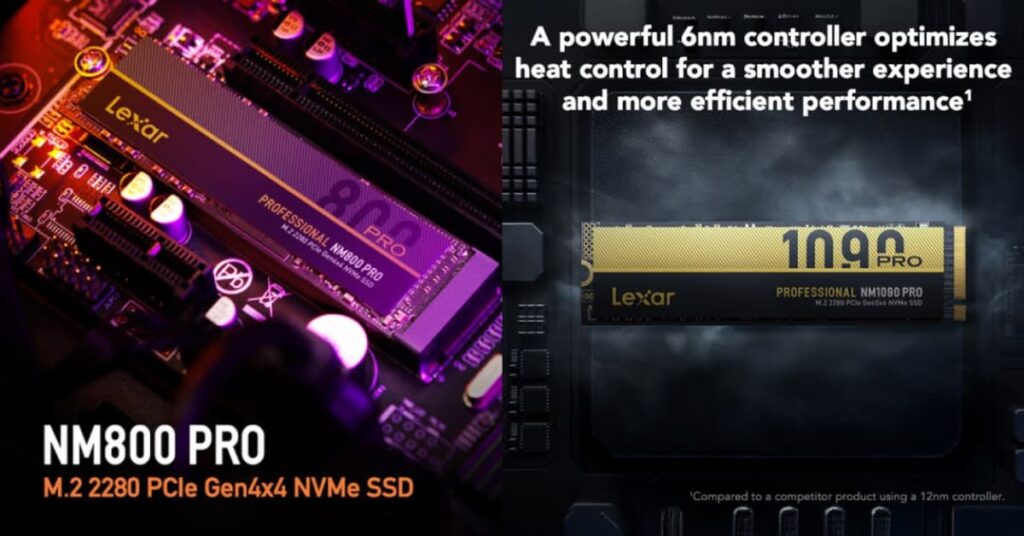
Real-World Applications: Where Our NVMe SSDs Make a Difference
Understanding NVMe technology becomes most meaningful when we examine how it impacts actual computing scenarios. The performance characteristics we’ve discussed translate into tangible benefits across various applications and use cases, benefits that our customers experience every day with our SSD products.
Content Creation and Professional Workflows
Video editors, graphic designers, and other creative professionals work with extremely large files that demand high-performance storage. A single 4K video project can involve hundreds of gigabytes of raw footage, with editing workflows requiring rapid access to multiple video streams simultaneously.
Lexar® Professional NM1090 PRO PCIe 5.0 SSD enables real-time editing of high-resolution content without the stuttering and delays common with traditional storage. With sequential read speeds up to 14,000MB/s and write speeds up to 13,000MB/s, it supports smooth playback of multiple 4K video streams while maintaining responsive scrubbing and editing operations.
Professional applications like Adobe Premiere Pro, DaVinci Resolve, and Final Cut Pro show measurable performance improvements with our high-performance NVMe storage, including faster project loading, smoother timeline scrubbing, and reduced rendering times. These improvements directly translate to increased productivity and reduced project completion times.
For photographers working with large RAW files, Lexar® Professional NM800 PRO M.2 2280 NVMe SSD provides the sustained write performance needed for burst shooting sessions while ensuring rapid image processing and catalog operations in applications like Lightroom and Capture One.
Gaming Performance Across Console and PC
Video games feature increasingly detailed worlds with massive texture files, complex geometry, and sophisticated audio assets. Traditional storage often becomes a bottleneck during level loading, texture streaming, and asset decompression operations.
Lexar® NM790 M.2 2280 PCIe Gen 4×4 NVMe SSD is compatible with PlayStation 5 consoles and dramatically reduces game loading times. More importantly, the consistent performance characteristics eliminate stuttering during gameplay caused by texture streaming and asset loading operations.
For PC gaming, Lexar® Professional NM1090 PRO PCIe 5.0 SSD with DirectStorage support enables new gaming experiences, such as near-instantaneous world transitions and more detailed environments that can be loaded dynamically without interrupting gameplay. The drive’s advanced thermal management ensures consistent performance even during extended gaming sessions.
The Lexar® NQ780 M.2 2280 PCIe 4.0 NVMe SSD provides excellent gaming performance at a more accessible price point, with read/write speeds up to 7,000/6,000MB/s that eliminate loading screen bottlenecks while maintaining budget-friendly pricing for gamers building or upgrading their systems.
Professional Development and Compilation
Software development involves frequent operations on large numbers of small files — source code, libraries, documentation, and build artifacts. Traditional storage performs poorly with these access patterns, leading to slow compilation times and reduced developer productivity.
Our NVMe SSDs excel at handling the random access patterns common in development workflows. The high 4K random IOPS performance of drives like our Lexar® Professional NM800 PRO M.2 2280 NVMe SSD — with 4K random read/write performance up to 1,300K/1,200K IOPS – enables faster file system operations, reduced compilation times, and more responsive development environments.
Large codebases that previously required minutes to compile can often build in seconds with appropriate NVMe storage, enabling rapid iteration and testing cycles that improve software quality and development velocity.
Database and Analytics Workloads
Database operations frequently involve complex query patterns that require rapid access to scattered data locations. Traditional storage often becomes a bottleneck for database performance, limiting transaction throughput and query response times.
NVMe SSDs enable databases to maintain larger working sets in storage-tier caching, reduce query latencies, and support higher transaction volumes. The combination of high sequential throughput and excellent random IOPS performance allows database systems to handle both large analytical queries and frequent transactional operations efficiently.
Modern analytics frameworks that process large datasets show significant performance improvements with NVMe storage, enabling faster insights and more interactive data exploration capabilities.
Advanced NVMe Features and Technologies
Beyond the fundamental performance advantages, our NVMe SSDs implement advanced features that enable new capabilities and optimize storage performance for specific use cases. These technologies represent ongoing evolution in storage capabilities and demonstrate our commitment to innovation.
Thermal Management and Performance Optimization
High-performance NVMe SSDs generate significant heat during intensive operations, which can lead to thermal throttling and reduced performance. Our engineering approach addresses this challenge through multiple strategies.
The Lexar® Professional NM1090 PRO PCIe 5.0 SSD features an advanced 6nm controller that operates at 36 percent lower peak temperatures compared to competing drives using older 12nm controllers. This thermal efficiency allows the drive to maintain peak performance for longer periods without thermal throttling.
For users who need maximum sustained performance, we offer the Lexar® Professional NM800 PRO with Heatsink M.2 2280 NVMe SSD, which includes an integrated heatsink and heat spreader label to effectively maintain speed, power efficiency, and thermal control during sustained high-performance workloads on both PC and PlayStation 5 systems.
Power Management and Battery Life
Modern NVMe SSDs implement sophisticated power management capabilities that enable precise control over energy consumption and thermal behavior. These features become increasingly important in mobile devices and laptops where battery life is critical.
Our Lexar® Professional NM800 PRO M.2 2280 NVMe SSD leverages its 12nm controller technology to produce lower power consumption and longer battery life for mobile computing scenarios. The drive can automatically enter lower power states during periods of inactivity while maintaining instant responsiveness when performance is needed.
The Lexar® NQ780 M.2 2280 PCIe 4.0 NVMe SSD features Intelligent Power Control that makes it perfect for laptop installations, balancing high performance with energy efficiency to extend system battery life without compromising responsiveness.
Software Tools and Management
We provide the Lexar DiskMaster SSD Management tool with our premium drives, including the Lexar® Professional NM1090 PRO PCIe 5.0 SSD and Lexar® NQ780 M.2 2280 PCIe 4.0 NVMe SSD. This comprehensive utility allows users to:
- Monitor drive health – Track critical parameters and detect potential issues before they become problems
- Perform firmware updates – Keep drives running with the latest optimizations and feature enhancements
- Manage drive data – Optimize storage allocation and performance settings
- Secure data erasure – Permanently delete sensitive files with cryptographic security
- Performance optimization – Fine-tune drive settings for specific use cases
Reliability and Quality Assurance
All Lexar products undergo extensive testing in the Lexar Quality Labs, facilities equipped with thousands of different cameras and digital devices to ensure performance, quality, compatibility, and reliability across diverse hardware configurations.
Lexar SSDs are built to last, featuring no moving parts and shock/vibration resistance that makes them significantly more durable than traditional mechanical storage. Whether it’s the robust construction of our Lexar® Professional NM1090 PRO PCIe 5.0 SSD or the reliable performance of our Lexar® NM790 M.2 2280 PCIe Gen 4×4 NVMe SSD, every drive is engineered for long-term dependability.

Choosing and Optimizing Lexar NVMe SSDs
Understanding how NVMe SSDs work provides the foundation for making informed storage decisions and optimizing system performance. The technical knowledge we’ve covered directly impacts practical purchasing and configuration choices among our product lineup.
Matching Drive Characteristics to Use Cases
Different applications benefit from different NVMe SSD characteristics, which is why we’ve engineered distinct products for specific use cases:
For Ultimate Performance: The Lexar® Professional NM1090 PRO PCIe 5.0 SSD delivers bleeding-edge performance with sequential read speeds up to 14,000MB/s and write speeds up to 13,000MB/s. 232-layer 3D TLC NAND, DRAM cache, and advanced 6nm controller make it ideal for professional content creators, competitive gamers, and power users who demand the absolute best performance.
For Balanced High Performance: The Lexar® Professional NM800 PRO M.2 2280 NVMe SSD offers exceptional performance with speeds up to 7,500MB/s read and 6,500MB/s write, making it perfect for hardcore gamers, professionals, and creators who need consistent high performance across diverse applications.
For Excellent Value: The Lexar® NM790 M.2 2280 PCIe Gen 4×4 NVMe SSD delivers impressive performance with speeds up to 7,400MB/s read and 6,500MB/s write, providing outstanding performance-per-dollar for gamers, content creators, and professionals who want high-end capabilities at a more accessible price point.
For Budget-Conscious Performance: The Lexar® NQ780 M.2 2280 PCIe 4.0 NVMe SSD offers solid PCIe 4.0 performance with read/write speeds up to 7,000/6,000MB/s, making it perfect for users upgrading from SATA SSDs or building cost-effective systems without compromising on modern NVMe performance.
Form Factor and Installation Considerations
All our current NVMe SSDs use the standard M.2 2280 form factor, which provides compact installation in modern laptops and desktops. The single-sided design of drives like the Lexar® NM790 M.2 2280 PCIe Gen 4×4 NVMe SSD makes them compatible with space-constrained installations while maintaining high capacity options up to 8TB.
For users who need enhanced thermal performance, our Lexar® Professional NM800 PRO with Heatsink M.2 2280 NVMe SSD includes an integrated cooling solution that’s perfect for high-performance gaming systems and professional workstations where sustained performance is critical.
PCIe generation compatibility is handled automatically – our PCIe 5.0 drives work perfectly in PCIe 4.0 and 3.0 systems, while PCIe 4.0 drives provide excellent performance in both current and legacy systems with automatic backwards compatibility.
Capacity Planning and Future-Proofing
Storage needs continue growing rapidly, making capacity planning increasingly important. Our NVMe SSDs are available in capacities ranging from 512GB to 8TB, allowing users to choose the right balance between performance, capacity, and budget.
For most users, we recommend starting with at least 1TB capacity to accommodate modern applications, games, and operating system requirements. Content creators and professionals often benefit from 2TB or larger capacities, while our 4TB and 8TB options provide extensive storage for professional workflows and large game libraries.
Performance Optimization Best Practices
To get the most from your Lexar NVMe SSD, consider these optimization strategies:
- Enable NVMe drivers – Ensure your system is using the latest NVMe drivers rather than generic AHCI drivers
- Use the Lexar DiskMaster tool – Keep firmware updated and monitor drive health regularly
- Maintain adequate free space – Keep at least 10-15 percent of drive capacity free for optimal performance
- Consider thermal management – Ensure adequate case ventilation or consider our heatsink-equipped models
- Enable write caching – Use operating system write caching features for improved performance
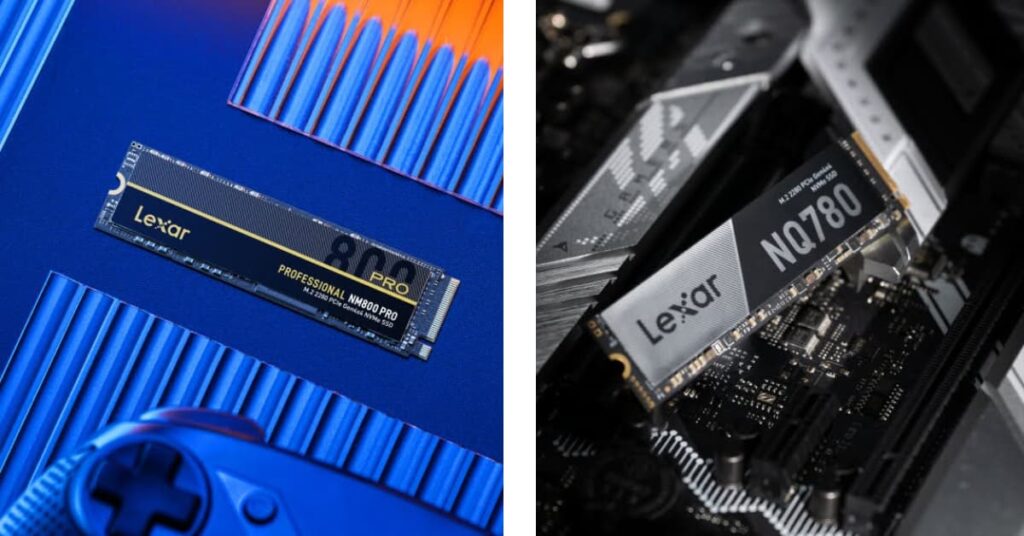
The Future of Storage: Lexar’s Innovation Roadmap
As the Lexar team, we’ve walked through the intricate world of NVMe SSD technology — from the fundamental physics of NAND flash memory to the sophisticated protocols that enable exceptional performance. This understanding transforms storage from a mysterious black box into a comprehensible, engineered system optimized for modern computing demands.
The journey from application click to data storage involves multiple layers of technology working in concert: operating systems optimizing access patterns, NVMe protocols managing communication efficiency, controllers orchestrating complex flash management operations, and NAND memory cells storing information at the atomic level. Each component contributes to the overall performance characteristics that make our NVMe SSDs indispensable for modern computing.
What makes this technology particularly exciting is how it enables new computing paradigms rather than simply improving existing ones. Real-time 4K video editing with our Lexar® Professional NM1090 PRO PCIe 5.0 SSD, instant application launches with our Lexar® Professional NM800 PRO M.2 2280 NVMe SSD, and responsive database operations with our Lexar® NM790 M.2 2280 PCIe Gen 4×4 NVMe SSD all become possible when storage performance no longer represents a fundamental system bottleneck.
The performance advantages we’ve discussed — microsecond latencies, multi-gigabyte per second throughput, thousands of concurrent operations — translate directly into improved user experiences and increased productivity across virtually every computing application. Whether editing videos with professional-grade storage, developing software with responsive file operations, or gaming with eliminated loading screens, our NVMe storage enhances system responsiveness in measurable ways.
Innovation Continues
Storage technology continues to evolve rapidly. PCIe 5.0 adoption is accelerating with drives like our Lexar® Professional NM1090 PRO PCIe 5.0 SSD leading the way. Emerging PCIe 6.0 standards promise even higher bandwidth capabilities, while new NAND architectures and alternative memory technologies offer improved performance and endurance characteristics.
At Lexar, we’re committed to advancing storage technology through continued innovation in controller design, NAND optimization, and system integration. Our comprehensive SSD lineup – from the high-value Lexar® NQ780 M.2 2280 PCIe 4.0 NVMe SSD to the flagship Lexar® Professional NM1090 PRO PCIe 5.0 SSD – leverages the principles discussed in this article to deliver reliable, high-performance storage that meets the demanding requirements of modern applications.
DirectStorage technology, computational storage capabilities, and advanced AI-driven optimization algorithms represent just the beginning of what’s possible with next-generation storage systems. Our engineering teams are already working on technologies that will further revolutionize storage performance and capabilities.
Making Informed Decisions
Understanding how NVMe SSDs work empowers users to make informed storage decisions, optimize system configurations, and appreciate the sophisticated engineering that enables modern computing performance. This knowledge becomes increasingly valuable as storage continues evolving and new technologies emerge.
Whether you choose our:
Lexar® Professional NM1090 PRO PCIe 5.0 SSD for ultimate performance
Lexar® Professional NM800 PRO M.2 2280 NVMe SSD for balanced high-end capabilities
Lexar® NM790 M.2 2280 PCIe Gen 4×4 NVMe SSD for exceptional value
Lexar® NQ780 M.2 2280 PCIe 4.0 NVMe SSD for budget-conscious performance,
You’re investing in technology that will transform your computing experience.
The storage revolution enabled by NVMe technology represents more than just faster file transfers – it fundamentally changes what’s possible with personal and professional computing. By understanding these underlying technologies and choosing the right Lexar SSD for your needs, users can better leverage storage capabilities and prepare for future developments in high-performance computing.
From content creators pushing the boundaries of 8K video production to gamers demanding zero-compromise performance, from developers building the next generation of applications to professionals managing massive datasets, our NVMe SSD lineup provides the storage foundation that makes ambitious projects possible.

